If you want to see the right way to make a sequel, you need look no further than Bleed 2. The same fantastic time-slowing, air dashing, run and gun gameplay from the original is back, but with an expanded character roster, a slightly smaller, yet more refined arsenal of weapons, and the addition of color-based bullet deflection. A new and very noticeable layer of polish has also been applied to everything from the graphics to the menus, improving upon the first game in virtually every way. 2017 has just started, but Bleed 2 is already looking like it will be a strong contender for one of the best games of the year.
Anyone who has played the original game will feel immediately familiar with the basic framework of Bleed 2 as much of the framework is identical. Taking on the role of Wryn, now renowned as the greatest (and only) hero in the world, you must once again fight your way through seven levels filled with dozens of boss fights in order to stop an attack by the Greatest Villains of All Time lead by the evil Valentine. You can still make use of an endlessly-replenishing energy bar to slow time and you still have access to the iconic and highly versatile triple air dash. There are also once again four difficulty settings ranging from Easy to Very Hard, you’re free to go back and replay any unlocked level on any difficulty at any time, and new weapons and characters are unlocked after completing the game on various difficulties. Even the Challenge Mode where you can fight any combination of up to three bosses in various arenas and the Arcade Mode where you are tasked with going through the entire game on a single life are back.
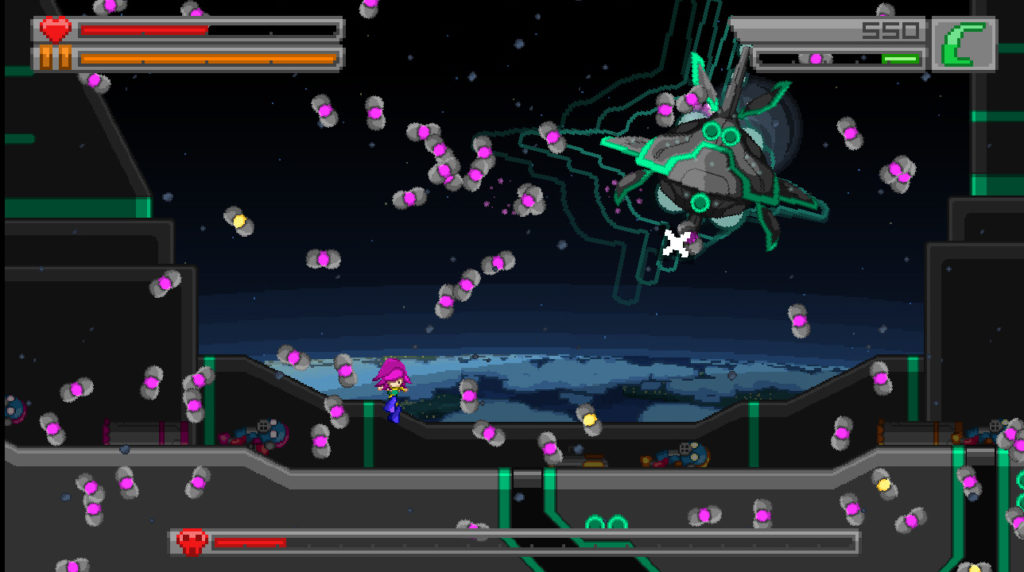
With all these structural similarities it might be easy to assume that Bleed 2 is simply the same game with different levels (not that that’s necessarily a bad thing), but that’s not actually the case. The basic structure created by Bleed was already a rather sturdy one so, instead of completely rebuilding it into something new, Bleed 2 keeps all of the best parts in place, reinforces or adjusts the weaker parts, and attaches new mechanics which work well alongside the existing ones. One of the most substantial, and immediately noticeable, differences comes in the form of the starting weapon. Instead of being presented with a set of pistols and a rocket launcher, you now start with two weapons rolled into one in the form of a sword and two pistols. Wryn will perform a close-range slash with the sword every time you press the attack button, but holding the button down will cause her to rapidly fire her pistols in whichever direction you’re aiming. While the pistols may have been a default weapon in the original, the sword was the most expensive weapon available in the shop and it was capable of deflecting any given projectile, so it may seem surprising to see it given to players so early this time around. The catch is that the sword can no longer counter all projectiles and instead plays into the new color system.
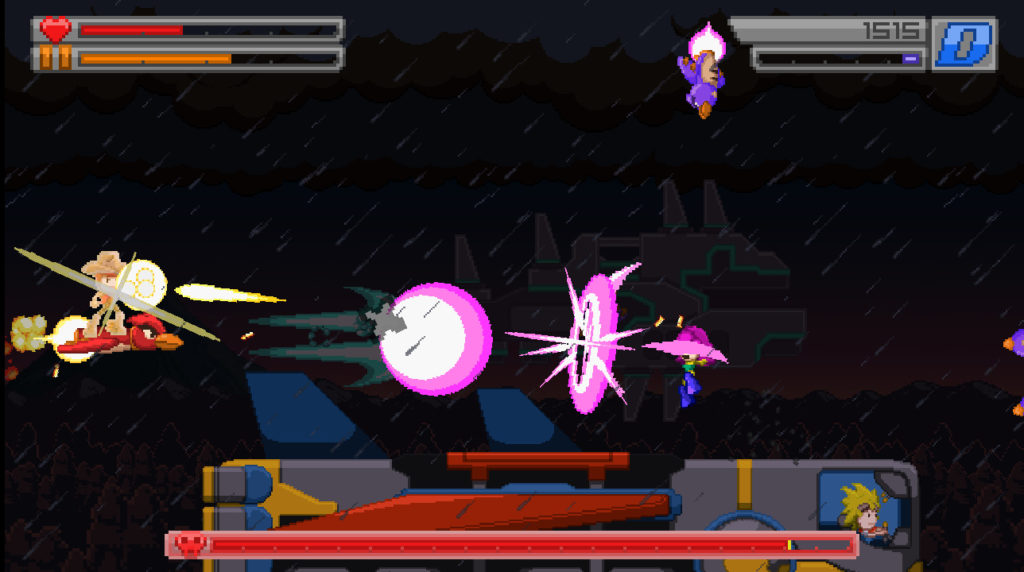
Purple and yellow are colors which players will undoubtedly become intimately familiar with in Bleed 2. All energy-based projectiles are either purple or yellow and Wryn’s sword is only capable of deflecting purple shots. Since the sword is part of your default arsenal, every fight incorporates this mechanic to let players take on a more offensive approach to defense as they dodge between yellow bullets while seeking out purple bullets to slash back at their opponents. These color mechanics aren’t just limited to energy bullets though as missiles and other solid projectiles will occasionally have a purple or yellow aura attached to them; whenever you see purple, it’s bound to signal a chance for Wryn to get some extra damage in. In fact, nearly every boss has a ‘big attack’ which will appear as one of the two colors and this attack usually takes on the form of a giant energy orb or missile or the boss itself will gain an aura as it charges at you. These attacks come fast and can lead to losing a substantial amount of health if you get hit by them, but a successful parry has a wonderfully tactile nature to it as the boss is slammed away, often entirely off of the screen, and loses a massive chunk of its health. If you don’t want to use the sword or just don’t like the color-based gameplay that’s fine too as the sword is completely optional. Every attack in the game can still be dodged without parrying and you start with the dual pistols and the sword as individual weapons in your arsenal in addition to the combined form; the sword on its own does a single slash followed by an endless flurry of close-range strikes while the pistols work the same as ever on their own, but they can be toggled into akimbo mode to shoot in opposite directions.
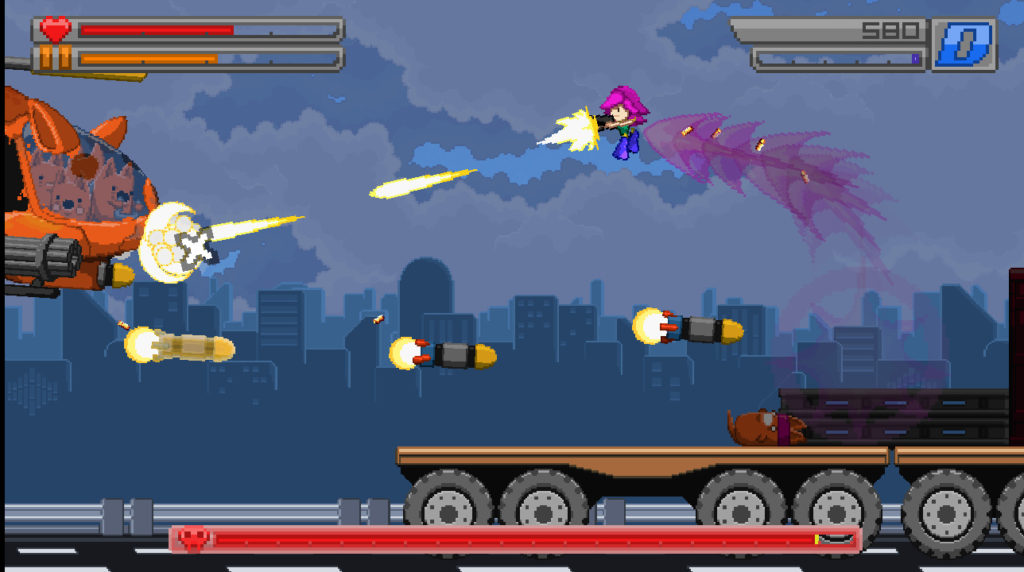
Another substantial change from the original game is the increased focus on boss fights this time around. Yes, bosses were always the focus in this series, but they truly take center stage here. Not only are there significantly more bosses to the point that every level has at least two bosses and some have as many as five, the final two levels outright consist entirely of boss fights and the non-boss segments of the first three levels are extremely short. On the one hand this means that Bleed 2 only has two levels where normal enemies and environmental hazards pose any serious threat beyond getting in a hit or two on even the highest difficulty. On the other hand, if you are playing a game in this series you are probably doing so primarily for the intense boss fights in the first place and not only are there more bosses, but the fights are even more well-crafted than in the original. Every boss still has plenty of attacks, but the color mechanics add another layer to the fights and many bosses now also change up their behavior when they get low on health by either substantially speeding up their attacks and possibly increasing their bullet count or by shifting into an entirely new second phase. As though to prove just how much the boss design improves upon that of the original, many of the bosses from the first game are reincarnated in this one with new twists on their attacks and a few nasty surprises for anyone who relies too heavily upon their memories from the original. Of course, there are also plenty of entirely new fights as well with some of my personal favorite bosses being a samurai who will block all of your attacks until he has drawn his sword to launch his own attacks and a ship which shoots out mine clusters which it then uses gravity to push outward, pull inward, and rotate around.
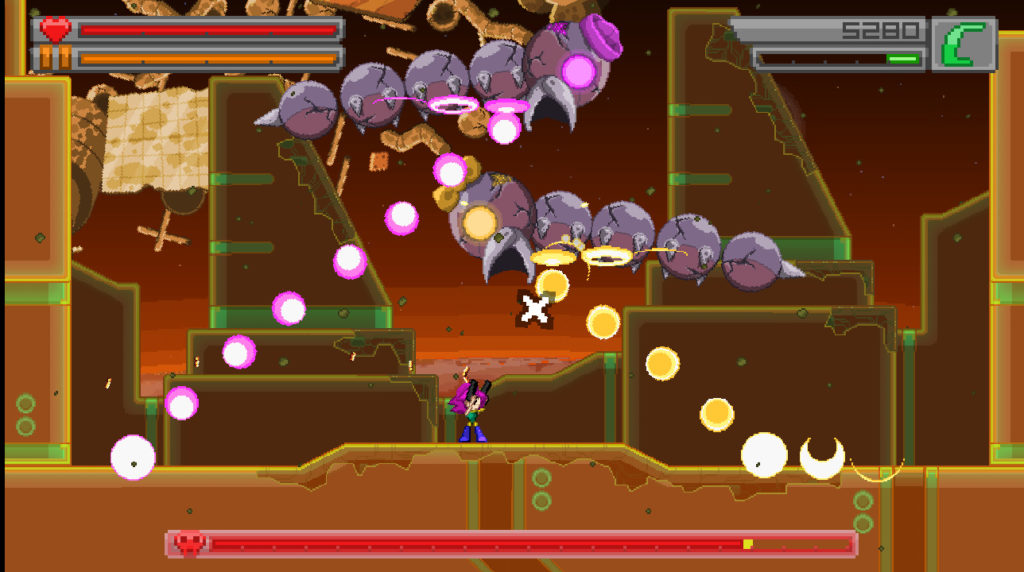
I’ve mentioned that Bleed 2 has received a fresh layer of polish, but the extent to which this polish has been applied is honestly incredible. The aesthetics are the most obvious improvement here with smoother, more detailed sprites, more animations, and far more intricate environments, especially the background while sound effects are more satisfyingly visceral and the sound quality of the music has almost been improved (though the tracks from the first game still hold up). These changes also carry over to the storytelling side of things with small cutscenes in the form of news reports after every level and the levels now flow together to tell a specific story rather than feeling like disconnected challenges. In terms of aesthetics, Bleed 2 lives up to the standard expected of a a modern top-tier indie game. I thought the menus were the weakest part of Bleed between the cumbersome weapon select and the fact that several major elements, such as new characters, were tucked away within submenus with no notifications appearing when they were unlocked. Bleed 2 fixes every complaint I had in this regard and even improves upon some other areas for good measure. You still access your weapons from the pause menu while in levels, but now you can toggle your loadout to be as big or as small as you want rather than being stuck with two weapons at a time; you can stick with a single weapon or you can just as easily have quick swap access to two, three, four, or your entire arsenal if you feel like it. The character select menu is now a giant button at the top of the list of game modes after selecting Play from the main menu, a huge improvement over its obscure place in the ‘Extras’ menu the first time around, and you are presented with a detailed unlock screen every time you gain access to something new. There’s now also an option to play the game in a window and your reticle when using a mouse is so customizable that not only can you adjust mouse sensitivity, but you also have control over its shape, color, size, and even the speed at which it spins. In addition to all of this, the scoring system and display have both been improved with score multipliers now being based on your style combo, time taken, and damage taken (i.e. taking a lot of damage can now negatively impact your score even if you don’t die) and your highest score and rank for every level on each difficulty is now clearly visible from the level select screen.
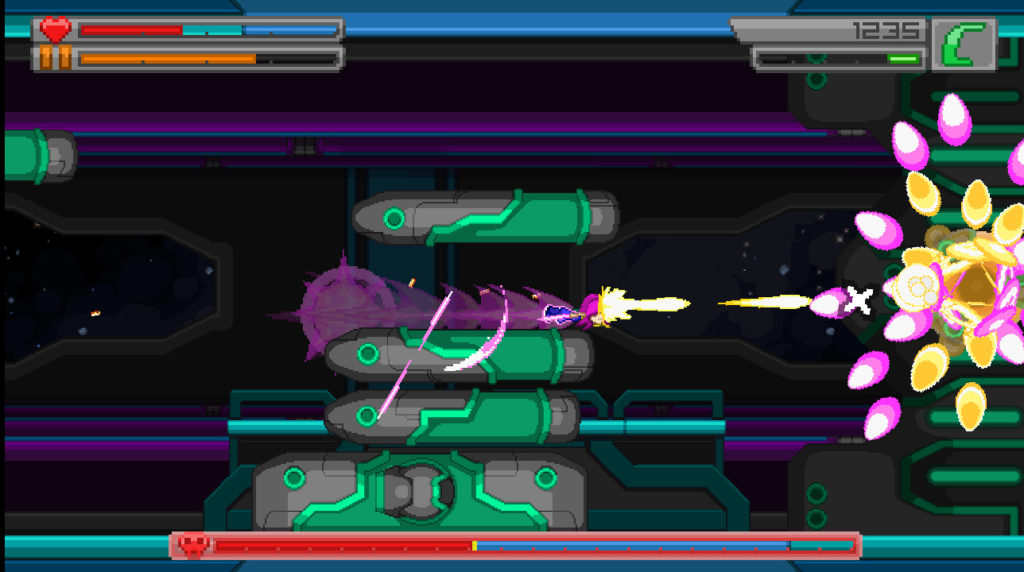
We’re still not done with the list of areas which have been polished up! The shop system has been completely removed and Wryn now starts the game with her full amount of health and energy and all unlocks are tied purely to beating the game on various difficulties. While I liked the sense of progression the shop gave in the first game, its removal means players are free to start on whichever difficulty they feel the most comfortable with rather than being compelled to start off on lower difficulties due to having small amounts of health and energy; the shop’s removal is a bit closer to a sidegrade than an upgrade, but I definitely prefer having the option to start out on higher settings without feeling overpowered and likewise being able to go back to earlier difficulties with new characters and weapons without feeling overpowered later on. The number of weapons to unlock has been slightly trimmed down, but the weapons have been more meticulously balanced and the total number of unlockables has actually increased as you can now gain access to replacements for the air dash, such as a teleport and a slower kick which deals damage when it connects with enemies.
The character roster has also been increased and many of the new characters have entirely unique movesets with character-specific attacks and movement options and new ways to interact with the color system, such as by having an Ikaruga-style shield which can be toggled to absorb one color or the other at the cost of not being able to slow time. Additionally, Arcade Mode has been expanded a bit as it is now separated into a ‘New Game’ mode which only lets you use Wryn and her starting weapons and a ‘Freestyle’ mode which lets you take along the character and weapons of your choice. If you’re looking for an even higher degree of challenge or want to simply change things up a bit, you can now also toggle on various mutators which can do anything from giving you infinite life to making bullets impossible to deflect alongside more bizarre options like displaying all hitboxes; you can’t save your score or unlock anything with mutators turned on, but they are a fun bonus to play around with.
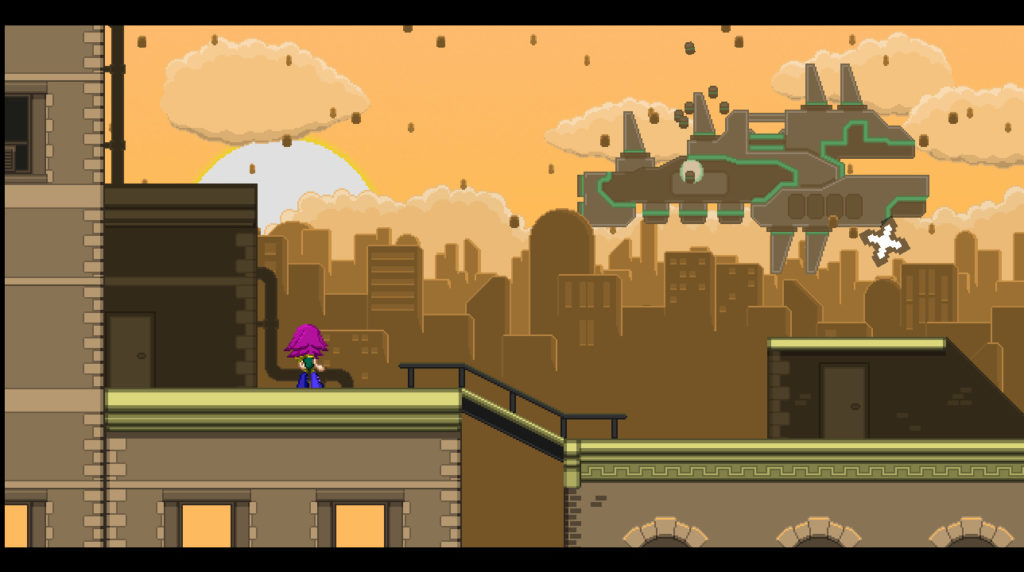
Before wrapping up this article, there is one last change worth pointing out in its own paragraph – the difficulty. Don’t worry, Bleed 2 is still just as intensely challenging as the first game. However, the difficulty this time around has more of a curve to it. The first game has a fairly flat degree of difficulty to it; it starts off as being incredibly hard (though still fair) and remains at about that same level throughout with some minor fluctuations here and there. This time around the game is still never easy, but the first level is noticeably less challenging than anything in the first game and the degree of challenge presented to players continues to consistently rise throughout to the point that it surpasses that of the original, though while still feeling entirely fair. Changes between difficulty settings are also even more pronounced here than in the first game, in large part due to the removal of the shop as every difficulty is balanced with the exact same amount of health and energy in mind. Bosses also factor heavily into the larger gap between difficulty settings as bosses now not only become more aggressive on higher difficulties, but also tend to have substantial changes to their attacks, such as by overlapping purple and yellow bullets on higher difficulties while keeping them more clearly spread apart on lower settings.
Bleed 2 is a game which all action platformer fans should rush to add to their collections. It takes everything great about the original and adds in new twists alongside subtle and blatant improvements across the board. As an incredible sequel to the already fantastic original, Bleed 2 is almost certainly destined to be remembered for many years to come.